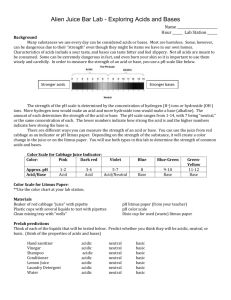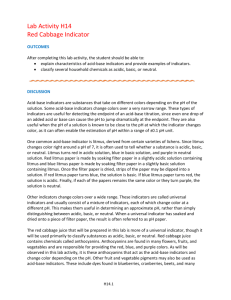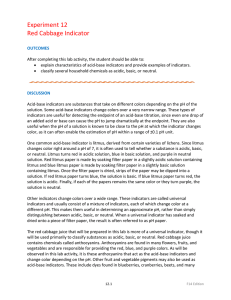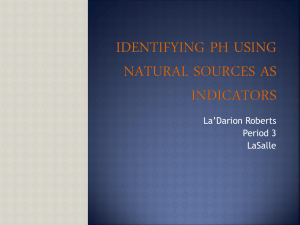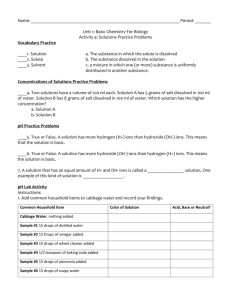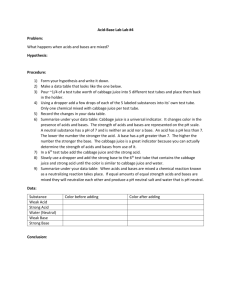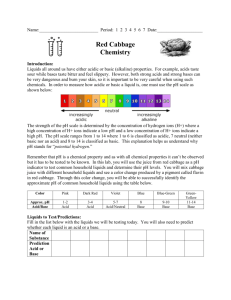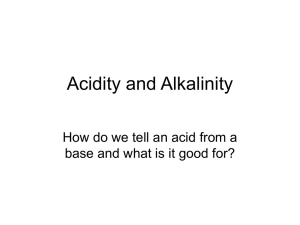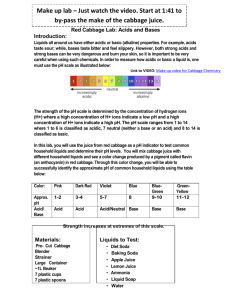Experiment 12
advertisement
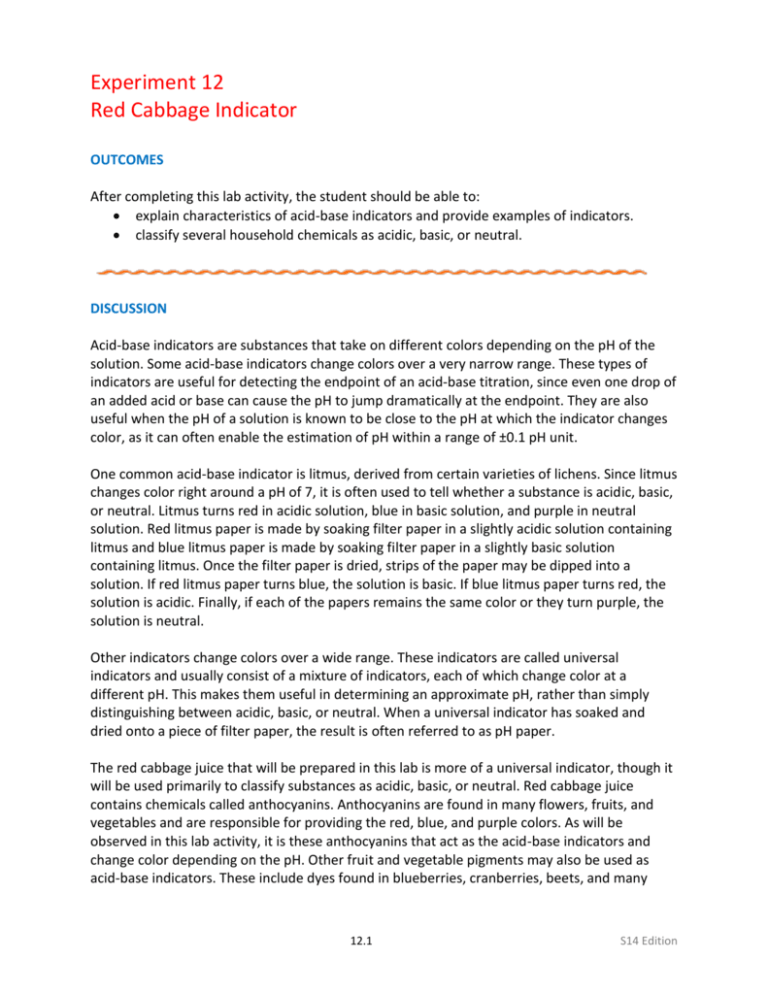
Experiment 12 Red Cabbage Indicator OUTCOMES After completing this lab activity, the student should be able to: explain characteristics of acid-base indicators and provide examples of indicators. classify several household chemicals as acidic, basic, or neutral. DISCUSSION Acid-base indicators are substances that take on different colors depending on the pH of the solution. Some acid-base indicators change colors over a very narrow range. These types of indicators are useful for detecting the endpoint of an acid-base titration, since even one drop of an added acid or base can cause the pH to jump dramatically at the endpoint. They are also useful when the pH of a solution is known to be close to the pH at which the indicator changes color, as it can often enable the estimation of pH within a range of ±0.1 pH unit. One common acid-base indicator is litmus, derived from certain varieties of lichens. Since litmus changes color right around a pH of 7, it is often used to tell whether a substance is acidic, basic, or neutral. Litmus turns red in acidic solution, blue in basic solution, and purple in neutral solution. Red litmus paper is made by soaking filter paper in a slightly acidic solution containing litmus and blue litmus paper is made by soaking filter paper in a slightly basic solution containing litmus. Once the filter paper is dried, strips of the paper may be dipped into a solution. If red litmus paper turns blue, the solution is basic. If blue litmus paper turns red, the solution is acidic. Finally, if each of the papers remains the same color or they turn purple, the solution is neutral. Other indicators change colors over a wide range. These indicators are called universal indicators and usually consist of a mixture of indicators, each of which change color at a different pH. This makes them useful in determining an approximate pH, rather than simply distinguishing between acidic, basic, or neutral. When a universal indicator has soaked and dried onto a piece of filter paper, the result is often referred to as pH paper. The red cabbage juice that will be prepared in this lab is more of a universal indicator, though it will be used primarily to classify substances as acidic, basic, or neutral. Red cabbage juice contains chemicals called anthocyanins. Anthocyanins are found in many flowers, fruits, and vegetables and are responsible for providing the red, blue, and purple colors. As will be observed in this lab activity, it is these anthocyanins that act as the acid-base indicators and change color depending on the pH. Other fruit and vegetable pigments may also be used as acid-base indicators. These include dyes found in blueberries, cranberries, beets, and many 12.1 S14 Edition types of grapes. If desired, experiment with some of these to see what happens. Do you know of other common indicators? Can you find any others? PROCEDURE ⚠ Eye protection must be worn at all times during this experiment! ⚠ Keep chemicals used in this experiment away from pets, food, and children! 1. Prepare the red cabbage juice indicator by one of the two methods described below: Place about 1 L (1 qt) of distilled water into a small saucepan that has been thoroughly cleaned and rinsed. Tear up 3-4 leaves of red cabbage and add them to the water. Heat the mixture and to bring it to a boil. Once the water begins to boil, turn down the heat and simmer for about 10 minutes. Add more cabbage if a darker color is desired. Allow the mixture to cool and transfer it to a plastic or glass container. Place 3-4 leaves of red cabbage into a blender that has been thoroughly cleaned and rinsed. Add 1 L (1 qt) of distilled water to cover the leaves. Blend for several seconds. Add more cabbage if a darker color is desired. Filter the liquid into a plastic or glass container. If necessary, dilute with distilled water to yield 1 L of the cabbage juice. REQUIRED PHOTO: Includes the date clearly shown on a calendar, newspaper, cell phone, or written on a sheet of paper, with the prepared cabbage juice solution. The method of preparation should also be visible, whether done by heating or in a blender. Acid and Base Standards 2. Prepare the acid and base standards as follows: Line up eight small cups filled with about 50 mL red cabbage indicator. Mark the fifth cup as the standard for comparison. Add 1 drop of household ammonia to the fourth cup, 2 drops to the third, 3 drops to the second, and 10-20 drops to the first. To the sixth cup, add 1 drop of white vinegar, to the seventh add 2 drops, and to the eighth add 10-20 drops. The result should be a beautiful variation in shades ranging from green to aqua to blue to violet to red. 12.2 S14 Edition Record your observations in the table. Note the color, number of drops, and whether the solution was acidic, basic, or neutral. Use adjectives like slightly, least, or most in identifying the acidic and basic solutions. (Example: most basic) Testing the Solutions 3. Obtain at least 10 different water-soluble substances to test with the cabbage juice indicator. You may test any substances you wish, but here are some suggested substances: salt, sugar, baking soda, rubbing alcohol, 7-Up (or other soda), milk, lemon juice, hydrogen peroxide, aspirin, acetaminophen, antacid tablets, soap, shampoo, household cleaners, fingernail polish remover, or mouthwash. The primary requirement is that the liquids are colorless or white, besides being water-soluble. 4. Test the water soluble substances selected to see whether they are acidic, basic, or neutral by placing 50 mL of cabbage juice indicator into a cup and adding 10-20 drops of the solution to be tested. Solids may be tested by adding an amount equal to a match head. Record your observations. 5. Tell whether each of the substances is acidic or basic by comparing the results to your standards. Adjectives like least, slightly, very, or most may be used in classifying the substances. (Example: slightly acidic) REQUIRED PHOTO: Includes your face and/or clearly shows a Picture I.D. (with name), showing all of the cups of cabbage juice (after the substances have been added and the color has changed), as well as the chemicals that were tested. 12.3 S14 Edition EXTENSIONS - PICK ONE (At least ONE extension is required for this week’s lab activity. Report on your choice.) ⚠ Keep chemicals used in this experiment away from pets, food, and children! pH of your Breath Using a straw, one may blow his/her breath through 50 mL of a red cabbage indicator solution to which one drop of ammonia has been added and observing any color change. Tip: Use slower, deeper breaths that come from your lungs rather than quick, shallow breaths that primarily exhale any air that was just inhaled. This step may take 5-10 minutes or more. Take a break if necessary. Cabbage Juice Paper Make cabbage juice paper (similar to litmus paper) using filter paper, napkins, construction paper, or paper towels – thicker, more absorbent paper works best. Soak some strips in the most acidic, most basic solutions, and neutral solutions and allow them to dry. Once they have dried, test the strips to see if they work. Using a darker cabbage juice (more leaves) should work the best. Other Natural Indicators Try extracting the juice from sources such as blueberries, red grapes, black grapes, grape juice, wine, beets and use them as acid-base indicators. Tip: avoid artificial colorings – most of these are not acid-base indicators. 12.4 S14 Edition Name Lab Section PRELAB QUESTIONS 1. Classify vinegar and ammonia as acidic, basic, or neutral. 2. Which pH values are expected for solutions that are acidic? basic? neutral? 3. Which safety precautions, if any, must be observed during this experiment? 12.5 S14 Edition 12.6 S14 Edition Name Lab Section DATA Acid and Base Standards Cup Substance Added Drops Color Acidic, Basic, or Neutral? Drops Color Acidic, Basic, or Neutral? 1 2 3 4 5 6 7 8 Testing the Solutions Cup Substance Tested 1 2 3 4 5 6 7 12.7 S14 Edition Testing the Solutions (cont’d) *optional Cup Substance Tested Drops Color Acidic, Basic, or Neutral? 8 9 10 11* 12* 13* 14* 15* EXTENSION Report the data obtained here. 12.8 S14 Edition Name Lab Section POSTLAB QUESTIONS 1. Comment on the results/observations of the experiment. (Were they what you expected? Were there any surprises? Did you have any trouble? Do you have suggestions for the future with this lab?) 2. What color would be expected if the following were added to red cabbage juice? Tell whether they are acidic, basic, or neutral. Substance Color Expected Acidic, Basic, or Neutral? Sodium hydroxide Hydrochloric acid A solution with a pH = 3 A solution with a pH = 7 A solution with a pH = 11 3. Explain the results from your chosen extension. 12.9 S14 Edition 12.10 S14 Edition
